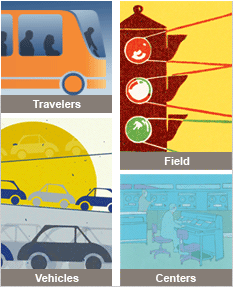About ITS Standards
Application Areas
Application areas are deployment-oriented categories that focus on commonly deployed ITS services or systems. Application areas provide a starting point for identifying the ITS standards and other resources (e.g., case studies, lessons learned) that may be relevant to a specific type of deployment.
System Types
 The
National ITS Reference Architecture, also known as ARC-IT, is divided into interface classes, which are further subdivided into application areas. Interface classes are defined by the type of system at each end of the communications path: center, field, vehicle, and traveler. An application area within the center-to-field interface class would include bidirectional communication between a center-type system (e.g., traffic management center) communicating with a field-type system (e.g., roadway equipment).
The
National ITS Reference Architecture, also known as ARC-IT, is divided into interface classes, which are further subdivided into application areas. Interface classes are defined by the type of system at each end of the communications path: center, field, vehicle, and traveler. An application area within the center-to-field interface class would include bidirectional communication between a center-type system (e.g., traffic management center) communicating with a field-type system (e.g., roadway equipment).
To determine which standards may be applicable, first identify the interface class for which you are looking for a standard, then find the application area within that interface class that best describes the project component. Use the table below to learn more about application areas and associated standards.
ITS projects will relate to one or more application area.
During the initial phases of a deployment, decisions should be made regarding:
- The specific information flows from ARC-IT to be implemented, and the corresponding standards mapped to those flows.
- The specific communications protocols to be used in the deployment, and corresponding standards.
- The specific types of messages to be used in the deployment.
Contact your local FHWA ITS Division Specialist or an ITS Standards Program Field Support Team contact for additional help.
ITS Standards Application Areas Table
| Interface Class | Standards Application Areas |
|---|---|
| Center to Center – This class of application areas includes interfaces between transportation management centers. |
Data Archival Incident Management Rail Coordination Traffic Management Transit Management Traveler Information |
| Center to Field – This class of application areas includes interfaces between a management center and its field equipment (e.g., traffic monitoring, traffic control, environmental monitoring, driver information, security monitoring, and lighting control). |
Data Collection/Monitoring Dynamic Message Signs Environmental Monitoring Lighting Management Ramp Metering Traffic Signals Vehicle Sensors Video Surveillance |
| Center to Vehicle/Traveler – This class of application areas includes interfaces between a center and the devices used by drivers or travelers. It includes interfaces with motorists and travelers for exchange of traveler and emergency information as well as interfaces between management centers and fleet vehicles to support vehicle fleet management. |
Mayday Transit Vehicle Communications Traveler Information |
| Field to Field – This class of application areas includes interfaces between field equipment, such as between wayside equipment and signal equipment at a highway rail intersection. |
Highway Rail Intersection (HRI) |
| Field to Vehicle – This class of application areas includes wireless communication interfaces between field equipment and vehicles on the road. |
Probe Surveillance Signal Priority Toll/Fee Collection |